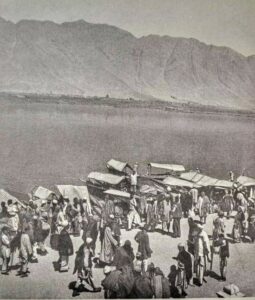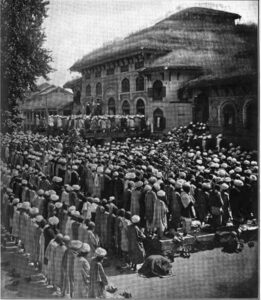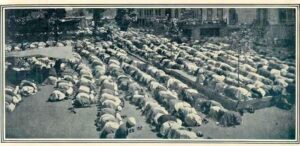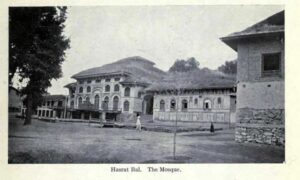Hazratbal is a neighborhood in Srinagar, the capital of Kashmir, famous for a historical seventeenth century shrine. The shrine holds high reverence amongst Muslims for it houses a holy relic, the sacred hair of Prophet Muhammad’s beard. This mosque is an epitome of love and devotion of Muslims for the Prophet. The construction of this shrine in a new architectural style started in 1968, under the supervision of Muslim Auqaf Trust headed by Sheikh Mohammad Abdullah. The construction of this white marble edifice with a domed structure was completed in the year 1979. The earlier architectural structure of the shrine was a pagoda style as popular in south and southeast Asia.
The place where the mosque stands today was originally the site of Ishrat Mahal and a garden, which were built in 1623 by Shah Jahan’s subedar Sadiq Khan. Upon his arrival in 1634, Shah Jahan ordered to convert the garden and accompanying into a place for offering prayers. When Moi-e-Muqqadas, or the holy relic, arrived in Kashmir in 1699, it was kept in the Naqashbad Sahib for some time, before becoming a part of the Hazratbal. Although this shrine is frequented by locals on Fridays for mass prayers, visitors come in lakhs when the holy relic is displayed on special days.
Hazratbal Shrine was initially established by Inayat Begum, the daughter of Khwaja Nur-ud-Din Eshai and the custodian of the holy relic. The first building of the shrine was constructed in 17th century by Mughal subedar Sadiq Khan during the emperor Shah Jahan’s reign.
The relic was first brought to Kashmir by Syed Abdullah Madani, a purported descendant of the holy Muhammad who left Medina and settled in the South Indian city of Bijapur in 1635, at a time when the Islamic Mughal Empire was rapidly expanding across India.
Following Abdullah Madni’s death, his son Syed Hameed inherited the relic. The region was conquered by the Mughals shortly afterwards, and Hameed was stripped of his family estates. Finding himself unable to care for the relic, he passed it to Khwaja Nur-ud-Din Eshai, a wealthy Kashmiri businessman.
There is a long story of how the holy relic traveled and arrived in Srinagar. The caretakers of the shrine are known as nishandeh. The eldest male heirs of the previous nishandeh continue the legacy of displaying the relic when their predecessor dies

























